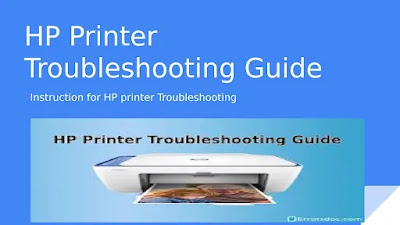HP Printer Troubleshooting Guide For Common Issues
Are you frustrated because your HP printer is acting up again? Don't worry; you're not alone. Printer problems can be a real headache, but fear not, we're here to help. In this comprehensive guide, we'll walk you through common HP printer issues and their solutions, using simple language that anyone can understand. No tech jargon, no complex terms—just straightforward
HP printer Troubleshooting guide. So, let's get started on your journey to hassle-free printing!
1. Printer Not Responding
Is your printer completely unresponsive? When you hit the print button, and nothing happens, it can be infuriating. Here's what you can do:
Check the Power: Ensure your printer is plugged in and turned on. Sometimes, it's the simplest things that cause the most trouble.
Connection Matters: Verify that the printer is connected to your computer correctly. Loose cables can lead to unresponsiveness.
Restart It: Sometimes, all your printer needs is a little break. Turn it off and on again to reset it.
2. Slow Printing Speeds
Is your printer taking forever to produce a single page? Slow printing can be frustrating, especially when you're in a hurry. Here's how to speed things up:
Change Print Quality: Lower the print quality for everyday documents. This will save time and ink.
Update Drivers: Ensure your printer drivers are up to date. Outdated drivers can slow down your printer.
Network Check: If you're printing wirelessly, check your Wi-Fi connection. A weak signal can cause delays.
3. Paper Jams: A Frequent Annoyance
Have you ever faced the dreaded HP printer paper jam error? It's a common issue, but you can tackle it effectively:
Clear the Jam: Open the printer carefully and remove any stuck paper. Follow your printer's manual for guidance.
Use Quality Paper: Cheap or damp paper is more likely to jam. Invest in good-quality paper for smooth printing.
Proper Loading: Ensure that you load the paper correctly in the tray to avoid jams.
4. Ink or Toner Cartridge Problems
Are you getting faint prints or error messages related to ink or toner? Cartridge issues can be bothersome, but there are solutions:
Check Levels: Make sure your ink or toner cartridges have sufficient levels. Replace them if needed.
Clean Printhead: If prints are streaky, clean the printhead using your printer's built-in maintenance tools.
Use Genuine Cartridges: Generic cartridges may save money, but they can cause compatibility problems. Stick to genuine HP cartridges for reliability.
5. Low-Quality Prints
Is your printer churning out prints that look nothing like the original? Don't worry; you can improve print quality:
Adjust Settings: Play around with the print settings. Choose a higher quality for better results.
Check Paper Type: Ensure that you're using the right paper type for your print job. Different paper types yield different results.
Clean Printer Heads: Over time, printer heads can get clogged. Follow your printer's manual to clean them.
6. Wireless Connection Woes
Struggling to connect your printer wirelessly? A reliable wireless connection is crucial. Here's what you can do:
Reboot Router: Sometimes, all it takes is a router reboot to fix connectivity issues.
Update Firmware: Check if your printer has a firmware update available. Installing it can resolve connectivity problems.
Reconfigure Connection: Disconnect and then reconnect your printer to the Wi-Fi network. Double-check the password.
7. Print Spooler Errors
Are you encountering print spooler errors on your computer? These errors can disrupt your printing. Here's how to tackle them:
Restart Print Spooler: Go to the Services menu in Windows, locate the Print Spooler service, and restart it.
Clear Print Queue: Sometimes, a stuck print job can cause spooler errors. Clear the print queue and try again.
Update Operating System: Ensure your operating system is up to date, as updates often include fixes for such issues.
8. Driver Issues: Keeping It Updated
Are outdated printer drivers causing problems? It's essential to keep your drivers current:
Automatic Updates: Enable automatic driver updates in your computer's settings to stay up to date effortlessly.
Manual Update: Visit the HP website and download the latest drivers for your printer model.
Uninstall Old Drivers: Remove any old or unnecessary printer drivers that might be conflicting with the current one.
9. Printing Blank Pages
Is your printer producing blank pages instead of your documents? It's a frustrating situation, but you can resolve it:
Check Ink Levels: Ensure you have enough ink or toner in your cartridges.
Run Cleaning Cycles: Most printers offer a cleaning function that can unclog nozzles and get the ink flowing again.
Inspect Settings: Review your print settings to make sure you haven't accidentally set it to "Blank Page."
10. Noisy Printing: The Printer Symphony
Is your printer making more noise than a rock concert? Printers can be noisy, but excessive noise might indicate an issue:
Clean Interior: Dust and debris can accumulate inside your printer, causing noise. Clean it periodically.
Check for Loose Parts: Ensure all parts are securely attached. Loose components can rattle and create noise.
Service Your Printer: If the noise persists, consider professional servicing to identify and fix the problem.
Conclusion
We've covered a range of common HP printer issues and provided you with straightforward solutions. Remember, troubleshooting printer error problems doesn't have to be a daunting task. With these tips in mind, you can tackle most issues on your own and enjoy smooth, hassle-free printing.
Frequently Asked Questions
Why is my HP printer not turning on?
If your printer isn't responding, check the power source and connections. Restart it, and it should come back to life.
How can I fix blurry prints from my HP printer?
Adjust the print quality settings and ensure you're using the right paper type for your print job. Cleaning the printhead may also help.
Why does my HP printer keep jamming paper?
Paper jams are often due to incorrect paper loading or using low-quality paper. Make sure you're loading paper properly and using good-quality sheets

.jpg)

Comments
Post a Comment